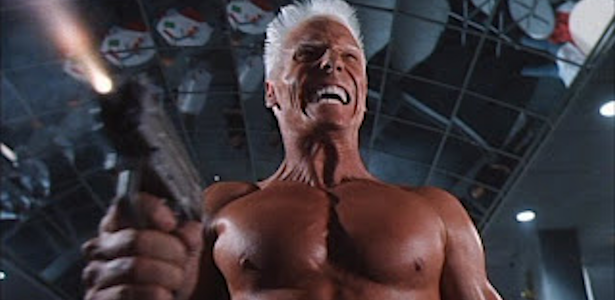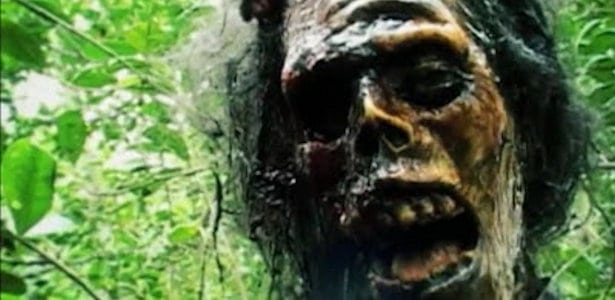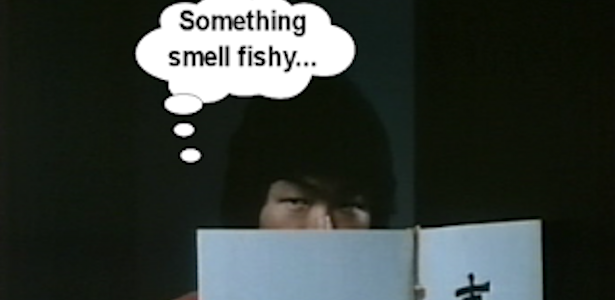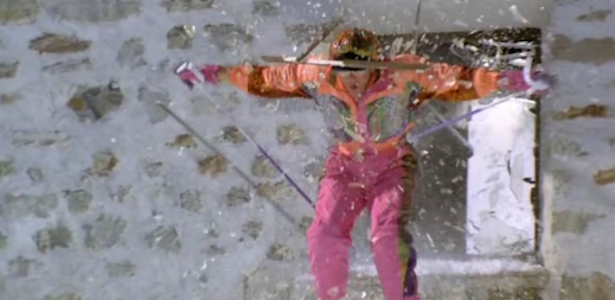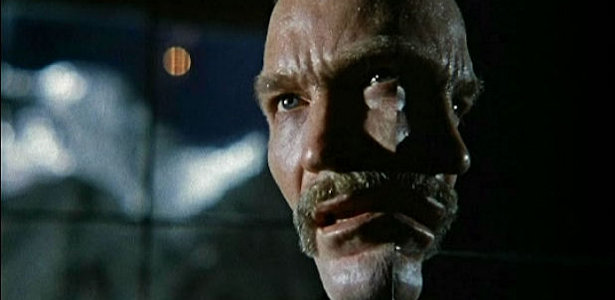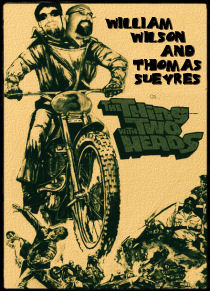The Hollywood Syndrome occurs when a film industry has a some breakaway hits that go global and provide an influx of cash. What to do? Well, that’s obvious, we need to get more projects just like the hits rolling immediately! The problem is, we need some guidance on how to make these profitable movies and who better to look to in such cases than the Americans. Just like McDonald’s proves on a daily basis, just because it makes money, doesn’t mean it’s any good. And so the industry gets watered down with cheap clichés and a lack of originality that made the films that started it all so successful in the first place.
The first film, released in 2010, sets up a reasonably intriguing, though somewhat well-used premise. An antiques/real-estate appraiser by the name of Orquicia was sent to the old Valdemar estate to check it out and evaluate the contents. The Valdemar estate is one of Spain’s only Victorian mansions and the estate agent figures it could be worth a fortune in antiques alone. Problem is, Orquicia hasn’t been heard from since he was dispatched some weeks ago. Hey, maybe he ran off with all of the contents and is now lounging on a beach somewhere. Certain that this could be the case (obviously nothing bad ever happens to people who visit presumably uninhabited Victorian mansions), the agent dispatches another appraiser, Louisa (Silvia Abascal), to go check it out.
 This flashback is quite literally the entirety of the film. We learn that Lasaro Valdemar (Daniele Liotti) and his wife, Leonor (Laia Marull), are charlatans who bilk rich idiots out of their family money by providing phony séances and photographing them. Though writer-director José Luis Alemán ensures that you have some sympathy for them when things get ugly, by having them use their ill-gotten gains to pay for the welfare of orphaned children. No, that sound you heard wasn’t a Lurker at the Threshhold, that was just me groaning. After being imprisoned when he refused to be blackmailed by a seedy journalist threatening to expose him, the only person who can save him is Alistair Crowley (Francisco Maestre) who concocts a scheme to get him out of the slams on the condition that Lasaro will perform a real séance with him for his special guests (who include Lizzy Borden, Bram Stoker, etc). Things don’t go quite as planned, the end.
This flashback is quite literally the entirety of the film. We learn that Lasaro Valdemar (Daniele Liotti) and his wife, Leonor (Laia Marull), are charlatans who bilk rich idiots out of their family money by providing phony séances and photographing them. Though writer-director José Luis Alemán ensures that you have some sympathy for them when things get ugly, by having them use their ill-gotten gains to pay for the welfare of orphaned children. No, that sound you heard wasn’t a Lurker at the Threshhold, that was just me groaning. After being imprisoned when he refused to be blackmailed by a seedy journalist threatening to expose him, the only person who can save him is Alistair Crowley (Francisco Maestre) who concocts a scheme to get him out of the slams on the condition that Lasaro will perform a real séance with him for his special guests (who include Lizzy Borden, Bram Stoker, etc). Things don’t go quite as planned, the end. Yes, I said “the end”. No, really. That’s it. But what happened to Louisa? What about the other appraiser? The estate agent and his secretary? Sorry, you got nothin’ for ya. Or if you saw it on video, you get a quick 20 second preview of the next film complete with CG Chthulhu and a year-long wait for the next film.
Yes, I said “the end”. No, really. That’s it. But what happened to Louisa? What about the other appraiser? The estate agent and his secretary? Sorry, you got nothin’ for ya. Or if you saw it on video, you get a quick 20 second preview of the next film complete with CG Chthulhu and a year-long wait for the next film.No wonder it didn’t get released here. Audiences would have rioted. The opening set up was decent (though completely unoriginal), but the flashback (aka the entire movie), was decent at best. Ham-handed, uninspired and over-long at worst. It felt like someone got wrapped up in their own ego and didn’t realize the flashback needed to be just that; a flashback. A film can set up a sequel, but it needs to have some sort of self-contained story arc within itself instead of just being half of a film, and an overly dry one at that. There’s a little bit of CG monster action at the end, but other than that don’t expect a single drop of anything horror (other than Louisa’s discovery of Orquicia’s corpse in the beginning) and it’s nothing we haven’t seen a thousand times before and a thousand times better. Adding insult to injury, Spain’s patriarch of the horror film, Paul Naschy, is confined to an almost wordless role as the Valdemar butler. Naschy could have easy been cast as Crowley and brought a great sinister presence to the role instead of Maestre, who’s obvious, one-note performance doesn’t do anything to help carry the rather flat story.
The sequel (or rather, the second half of the movie), THE FORBIDDEN SHADOW, was released a year later in 2011 and manages to correct a couple of the glaring issues with the first half, but introduces many more. Now all of the subplots are interwoven which makes them feel less uninspired than they really are. The main thrust of the plot is that all of the characters are kidnapped by the strange bug-collecting guy (who now, no longer does that), Damaso (José Luis Torrijo) and the caretaker, Santiago (Santi Prego). This happens straight away, after the opening sequence in which a bicycling Howard Philips Lovecraft (Luis Zahera) warns Lazaro about the dangers of Lazaro’s new favorite obsession, the Necronomicon. While Lovecraft often wrote that merely seeing one page could turn a lesser man’s brain inside out, Lazaro has been pouring over it for weeks and seems no less the worse for wear, complete with every strand of his immaculately blow-dried coiffeur in place. The only thing that gives a clue to the unimaginable madness within Valdemar are the cuffs of his shirt which are worn and dirty. This causes Jervas (Paul Naschy again desperately trying to rise above the table scraps he’s been handed) to beg for his return to sanity to no avail.
 |
| As you would expect, Lovecraft is the life of the party. |
 Back in the present day, everyone gets kidnapped and wake up in a “torture room” wearing festival masks (for no apparent reason), they panic and argue and you might get the impression you SAW this movie before. Before you get all excited the “torture room” is well lit with a comfy bed and not a speck of the old red-stuff to be found. But no matter, we’re going to run off head-long into more clichés! Yay, clichés! Drawing “inspiration” from other films such as THE DESCENT (2005) and (of all things) TOURIST TRAP (1979), the film plays out without actually employing any shocks or even conjuring any sense of dread. No miasma of terror, not even a spooky. Hell, there aren't even any gristly demises! That’s right, even though we have a cast of cookie-cutter characters, with one really uninspired exception, none of them are killed off or driven mad or really do anything except bicker with each other and try to escape their captors. And if you are looking for something more than TV-show acting chops, you are out of luck on that front too. The only moment that really does work is a scene where the deranged Santiago is wracked with distraught over the decapitation of one of his mannequins, who he believes to be a real woman. These little snatches of actual goodness are few and far between with most of the plot-points being not only ridiculously far fetched (how exactly do you abduct six hundred and sixty-six people from the same patch of woods without raising a single eyebrow?), but many are so predictable that you'll know exactly what is going to happen 20-30 minutes before the filmmakers jump out from behind the sofa and yell “surprise!”
Back in the present day, everyone gets kidnapped and wake up in a “torture room” wearing festival masks (for no apparent reason), they panic and argue and you might get the impression you SAW this movie before. Before you get all excited the “torture room” is well lit with a comfy bed and not a speck of the old red-stuff to be found. But no matter, we’re going to run off head-long into more clichés! Yay, clichés! Drawing “inspiration” from other films such as THE DESCENT (2005) and (of all things) TOURIST TRAP (1979), the film plays out without actually employing any shocks or even conjuring any sense of dread. No miasma of terror, not even a spooky. Hell, there aren't even any gristly demises! That’s right, even though we have a cast of cookie-cutter characters, with one really uninspired exception, none of them are killed off or driven mad or really do anything except bicker with each other and try to escape their captors. And if you are looking for something more than TV-show acting chops, you are out of luck on that front too. The only moment that really does work is a scene where the deranged Santiago is wracked with distraught over the decapitation of one of his mannequins, who he believes to be a real woman. These little snatches of actual goodness are few and far between with most of the plot-points being not only ridiculously far fetched (how exactly do you abduct six hundred and sixty-six people from the same patch of woods without raising a single eyebrow?), but many are so predictable that you'll know exactly what is going to happen 20-30 minutes before the filmmakers jump out from behind the sofa and yell “surprise!”At first I was a little peeved that Lovecraft’s name is proudly displayed in the credits and in the promotion while Alemán instead decides to pilfer from other sources. Lovecraft’s work is rich with material that can be translated to film, there is no need to ineptly ape SAW (2004) or anything else for that matter. On the other hand, we have seen some very entertaining films in the past that use Lovecraft as a mere springboard for some inspired lunacy. The aforementioned HOUSE BY THE CEMETERY is a great example. It really doesn't have a whole lot to do with Lovecraft at all, but if you had to quantify the one thing that makes Lovecraft Lovecraftian, it would be atmosphere and HOUSE has it by the gallon. Even if it only has the barest of Lovecrafts trappings. Unfortunately for us, Alemán manages to conjure some up some chiaroscuro, but makes sure that it is well used for dialogue scenes and little else. The underground caverns are also remarkably well lit. It must have taken days to set up the lighting and... oh, wait, they're CGI. Never mind.
 In addition to being blandly presented, the paltry few scenes that are supposed to have shocks are done without any subtlety or style. The zombie-like creature that was summoned during the séance in the beginning (or in the first film) is shown well lit and openly and for so long that the viewer has plenty of time to notice the flaws in the make-up (seriously, with all their abundant use of cheap CG, you’d think they could have made it look like something other than a guy in a mask). On the opposite end of the spectrum, it’s no spoiler to say that Cthulhu makes an appearance at the end (it is featured predominantly in the trailers, posters, and press material), and the way he (it?) is presented, it looks more fit for a video game than anything else. Like the zombie/demon creature, the over-exposure and the constant head-shots with the monster roaring spittle into the camera cheapens the whole effect and left me pining for the subtlety of THE CALL OF CTHULHU (2005) which pulled off, not only the whole Lovecraft thing, but summoned the great elder god from his eternal resting place beneath the sea with stunning results for a fraction of the budget and far fewer resources. As if that wasn’t enough, there are some moments in the end which might get a snicker or two out of the audience. If the fact that Cthulhu’s scale in relation to a human seems to slide drastically from shot to shot doesn’t get you, maybe the completely laughable botched human sacrifice scene will. Not that you won’t see that plot twist (like the rest) coming from miles away.
In addition to being blandly presented, the paltry few scenes that are supposed to have shocks are done without any subtlety or style. The zombie-like creature that was summoned during the séance in the beginning (or in the first film) is shown well lit and openly and for so long that the viewer has plenty of time to notice the flaws in the make-up (seriously, with all their abundant use of cheap CG, you’d think they could have made it look like something other than a guy in a mask). On the opposite end of the spectrum, it’s no spoiler to say that Cthulhu makes an appearance at the end (it is featured predominantly in the trailers, posters, and press material), and the way he (it?) is presented, it looks more fit for a video game than anything else. Like the zombie/demon creature, the over-exposure and the constant head-shots with the monster roaring spittle into the camera cheapens the whole effect and left me pining for the subtlety of THE CALL OF CTHULHU (2005) which pulled off, not only the whole Lovecraft thing, but summoned the great elder god from his eternal resting place beneath the sea with stunning results for a fraction of the budget and far fewer resources. As if that wasn’t enough, there are some moments in the end which might get a snicker or two out of the audience. If the fact that Cthulhu’s scale in relation to a human seems to slide drastically from shot to shot doesn’t get you, maybe the completely laughable botched human sacrifice scene will. Not that you won’t see that plot twist (like the rest) coming from miles away.Just like everyone else, I am sucker when it comes to director’s cuts and extended versions of movies; more is better, right? I love seeing the stuff that the studio cut out of movies to bring down the running time so they can squeeze an extra screening into theater bookings, or an extended cut of some film that some philistine producers butchered to try to make the movie they wanted. This is a completely different animal. This is essentially a three hour movie that really should have been cut down to say, 120 minutes at most. The story arc starts in one place, wanders almost randomly around, forgetting to focus on the Lovecraft that brought them to the dance, gets sidetracked with ideas that probably should have been left out in the screenwriting process and finally ends up in some serious Eldritch fromage that would have been hokey if it had been in a video game. Matter of fact, the Xbox "Call of Cthulhu" video game offered up far more fleshcrawling Lovecraftian entertainment than this could ever hope to. The blasé delivery and numerous pointless subplots make this something that obsessive completists will want to check out, but otherwise is proof that like Franco, Spanish horror is still dead.




